Note: The Nova program is administered at the Council level. Check with your local council about availability before starting on a Nova award.
Fearful Symmetry is the Cub Scout Nova Award for investigating the properties of symmetry.

The Tyger By William Blake
“Tyger Tyger, burning bright,In the forests of the night;
What immortal hand or eye,
Could frame thy fearful symmetry?”
This module is designed to help you explore how symmetry affects your life each day.
To earn the Fearful Symmetry Nova award, Scouts must complete one of their adventure related to patterns and symmetry. They explore how symmetry is found in art and nature.
The Fearful Symmetry Nova award can be earned by young men and women who are members of Cub Scouts

Fearful Symmetry Cub Scout Nova Award for Mathematics Requirements
Cub Scout Fearful Symmetry Nova Award for Mathematics Workbook / Worksheet
Fearful Symmetry Answers and Helps
Fearful Symmetry Cub Scout Nova Award for Mathematics Requirement 1: Watch, Read, or Both
A. Watch an episode or episodes (about one hour total) of a show that involves symmetry, mirrors, or artistic patterns. Then do the following:
A-1. Make a list of at least two questions or ideas from what you watched.
A-2. Discuss two of the questions or ideas with your counselor.
B. Read (about one hour total) about anything that involves symmetry, mirrors, or artistic patterns. Then do the following:
B-1. Make a list of at least two questions or ideas from what you read.
B-2. Discuss two of the questions or ideas with your counselor.
C. Do a combination of reading and watching (about one hour total) about anything that involves symmetry, mirrors, or artistic patterns. Then do the following:
C-1. Make a list of at least two questions or ideas from what you read and watched.
C-2. Discuss two of the questions or ideas with your counselor.
Video Suggestions
Website Suggestions
Fearful Symmetry Cub Scout Nova Award for Mathematics Requirement 2: Cub Scout Adventure or Investigation
Complete ONE adventure from the following list, or complete option A or B. (If you choose an adventure, choose one that you have not previously earned.) Discuss with your counselor what kind of science, technology, engineering, or math was used in the adventure.
Wolf Cub Scouts: Air of the Wolf or Code of the Wolf
Bear Cub Scouts: Forensics or Marble Madness
Webelos Scouts: Art Explosion or Build It
Option A: Complete all of the following:
(a) Explain the difference between the symmetry of the flower of a geranium and the symmetry of the flower of herbaceous periwinkle.
(b) Explain the difference in leaf arrangement (the pattern of where leaves appear on the stem) between a maple tree and a sweetgum tree.
(c) Find another pair of plants that you can distinguish based on some difference in symmetry.
Option B: Complete all of the following:
(a) Using toothpicks and colored marshmallows, or other appropriate materials, make a model of the crystal structure of olivine. (b) Using toothpicks and colored marshmallows, or other appropriate materials, make a model of the crystal structure of halite.
(c) Use your models to guess which of the two minerals is harder.
Symmetry in Plants: Background Information for Fearful Symmetry Option 2A
WHAT IS THE DIFFERENCE BETWEEN THE SYMMETRY OF A GERANIUM AND A HERBACEOUS PERIWINKLE?
The symmetry of a flower refers to how its various parts are arranged around its center. There are two main types of symmetry found in flowers: radial symmetry and bilateral symmetry.
Radial symmetry is where the flower can be divided into identical halves by multiple planes passing through its center, resulting in a circular or star-like shape. On the other hand, bilateral symmetry is where the flower can be divided into two identical halves by only one plane passing through its center, resulting in a more elongated, mirror-image shape.
The flower of a geranium typically exhibits bilateral symmetry. It has a central axis that runs along its length, and the petals and other flower parts are arranged in a mirror-image fashion on either side of this axis. Thus, if you were to draw a line down the center of a geranium flower, you would find that the two halves are nearly identical.
In contrast, the flower of herbaceous periwinkle exhibits radial symmetry. Its petals and other flower parts are arranged around a central point, such that multiple planes passing through this point would divide the flower into identical halves. Thus, the flower of herbaceous periwinkle is circular or star-like in shape.
WHAT IS THE DIFFERENCE IN LEAF ARRANGEMENT BETWEEN A MAPLE TREE AND A SWEETGUM TREE?
Maple trees have an opposite leaf arrangement, which means that two leaves emerge from the stem at the same point, on opposite sides of the stem. The pairs of leaves alternate along the stem. This creates a distinctive pattern of paired leaves that run along the stem. The leaf stems, or petioles, of each pair of leaves are attached at the same point on the stem, and the two leaves are mirror images of each other. The opposite leaf arrangement is a characteristic feature of many plants in the maple family, including sugar maple, red maple, and silver maple.
Sweetgum trees, on the other hand, have an alternate leaf arrangement, where a single leaf emerges from the stem at each point. The leaves alternate along the stem, rather than being paired, as in the case of maple trees. This means that the leaves are not attached at the same point on the stem, and they do not have mirror images of each other. The alternate leaf arrangement is common in many different types of trees, including oak, hickory, and dogwood.
WHAT ARE SOME PAIRS OF PLANTS THAT YOU CAN DISTINGUISH BASED ON SOME DIFFERENCE IN SYMMETRY?
Here are some other pairs of plants that can be distinguished based on some difference in symmetry:
Iris and buttercup – Iris flowers exhibit bilateral symmetry, with the petals and sepals arranged in a mirror-image fashion, while buttercup flowers exhibit radial symmetry, with the petals and sepals arranged around a central point.
Pea and snapdragon – Pea flowers exhibit bilateral symmetry, with the petals arranged in a distinct upper and lower lip, while snapdragon flowers exhibit bilateral symmetry, with the petals arranged in a tube shape with a mouth at the top.
Rose and daisy – Rose flowers exhibit radial symmetry, with the petals arranged around a central point, while daisy flowers exhibit bilateral symmetry, with the petals arranged in a circular pattern around a central disk.
Tulip and lily – Tulip flowers exhibit radial symmetry, with the petals arranged around a central point, while lily flowers exhibit bilateral symmetry, with the petals arranged in a mirror-image fashion.

Air of the Wolf Adventure
For this adventure, Wolves learn about activities which can be done using air – paper airplanes, balloons, music, kites, and more.

Code of the Wolf Adventure
Wolf Cub Scouts learn about numbers, measuring, shapes, and math for the Code of the Wolf adventure. They also get to try sending a message using code

Bear Forensics Adventure
Bear Cub Scouts learn about law enforcement methods which are used to solve crimes. Bears will learn how to fingerprint. They also explore chromatography, analysis, and other crime-solving techniques.
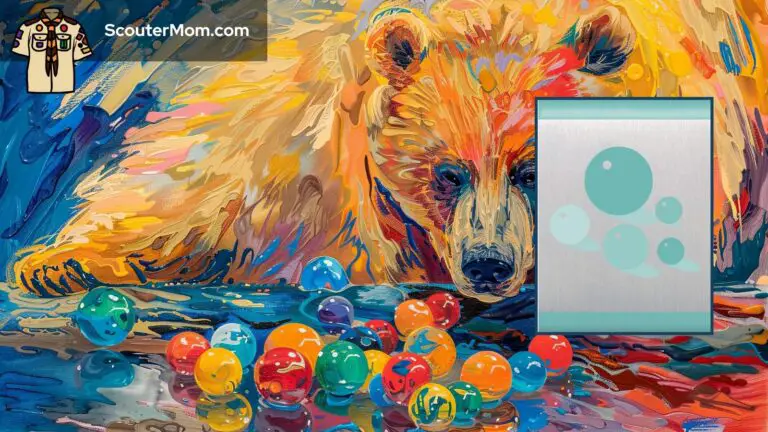
Bear Marble Madness Adventure
Bears learn all about marbles and play a variety of games with them, from ringer to marble mazes.

Webelos/AOL Art Explosion Adventure
Art Explosion is one of the Webelos/Arrow of Light elective adventures. For the Art Explosion adventure, Webelos learn about all types of art – drawing, painting, sculpture, origami, digital art, graphic design, photography, comics, and more.

Webelos/AOL Build It Adventure
Webelos learn about using tools safely and carpentry. Then they use what they have learned to build a project.
Fearful Symmetry Cub Scout Nova Award for Mathematics Requirement 3: Symmetry in Folk Art
Choose TWO options from A or B or C or D or E , and complete ALL the requirements for the options you choose.
A. Make a paper lantern.
A-1. Fold a large piece of paper in quarters lengthwise.
A-2. Cut decorative or symbolic shapes into the two folded edges.
A-3. Unfold, tape the two edges of the paper together, and smooth into a cylinder. Hang by a string.
B. Learn about the kolam artwork of southern India.
B-1. Look at some pictures of kolams. Find as many similarities as possible within each kolam. Is there a repeated pattern? If you turn it a little, do you get the same picture? If you look at it in a mirror, do you get the same picture?
B-2. Use sand, chalk dust, flour, or some other material to make a kolam of your own.
C. Learn about the litema wall decorations from Lesotho and South Africa.
C-1. Look at some pictures of litema. What does one basic tile look like? In how many ways can you see that tile arranged (turned a different direction, flipped backward, etc.)
C-2. Use clay, paper, or some other material to make a litema of your own.
D. Learn about the design of Navajo rugs.
D-1. Look at some pictures of Navajo rugs. Find as many similarities as possible within each rug. Is there a repeated pattern? Is there a mirror image? How many?
D-2. Using different colors of paper, or other materials, make your own Navajo-like rug.
E. Learn about Seminole or Miccosukee patchwork designs.
E-1. Look at some pictures of Seminole or Miccosukee patchwork. Find as many similarities as possible within each piece. What does a basic block of each pattern look like? How many different basic blocks are used in the design?
E-2. Using different colors of paper, or other materials, make your own Seminole-like patchwork.
Kolams: Background Information for Fearful Symmetry Option 3B
WHAT IS KOLAM?
Kolam is a traditional form of artwork that is practiced in southern India. It is a form of drawing that is done using rice flour, chalk, or colored powders. It is usually drawn at the entrance of homes, temples, and other public places as a sign of welcome and as a way of inviting prosperity.
WHAT ARE THE TYPICAL ELEMENTS OF KOLAMS?
Kolam designs are typically made up of geometric shapes such as squares, circles, and triangles. The designs are often intricate and symmetrical, with many repeating patterns. The design is created by drawing lines and dots on the ground or floor, which are then connected to form the final shape.
WHY ARE KOLAM DESIGNS A NOTABLE STYLE OF ART?
Kolam designs are often passed down from generation to generation, and different regions have their own unique styles and designs. Kolam is considered to be a form of folk art and is deeply rooted in the culture and traditions of southern India.
WHAT ARE SOME EXAMPLES OF KOLAMS?
Some photos of a variety of styles of kolams are shown below.


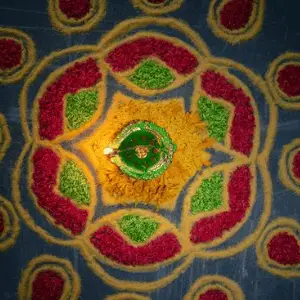


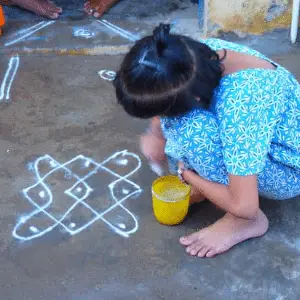



Navajo Rugs: Background Information for Fearful Symmetry Option 3D
WHAT IS THE MEANING OF THE PATTERNS ON NAVAJO RUGS?
The patterns on Navajo textiles are often inspired by the natural world, with motifs such as plants, animals, and landscapes being common. Other designs may be abstract, geometric, or based on traditional Navajo spiritual symbols. The resulting textiles are beautiful and intricate works of art that reflect the history and culture of the Navajo people.
WHAT TYPE OF SYMMETRY IS TYPICAL IN NAVAJO TEXTILES?
Symmetry is a common element found in Navajo rugs and textiles, although it is not always present in every design. When symmetry is used, it is often bilateral, meaning that the design is mirrored along a central axis. This can create a sense of balance and harmony in the overall composition.
It is worth noting that symmetry is not a universal feature of Navajo weaving, and there is a wide variety of styles and techniques used by Navajo weavers. Some weavers may use asymmetrical designs exclusively, while others may use a mix of symmetrical and asymmetrical elements in their work. Ultimately, the choice of design and the use of symmetry or asymmetry depends on the individual weaver and their creative vision for the piece.
WHAT ARE SOME EXAMPLES OF NAVAJO RUGS?
Some photos of a variety of symmetrical patterns which might be seen in a Navajo rug are shown below.

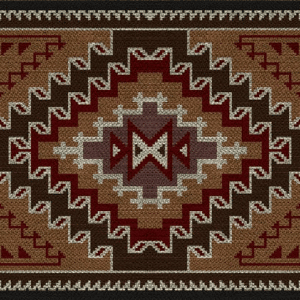


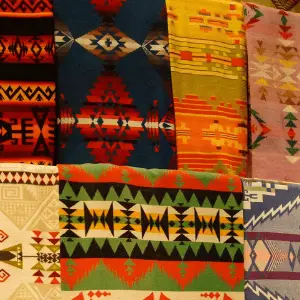




Fearful Symmetry Cub Scout Nova Award for Mathematics Requirement 4: Visit
Visit a place where symmetry is important (such as an art exhibit, building site, or printer) or visit with a person who works with symmetry (such as an artist, interior designer, or landscape architect). Discuss with your counselor the symmetry or ideas of balance involved.
People and Places to Visit to See Symmetry in the Real World
WHAT ARE SOME PLACES I CAN VISIT WHERE SYMMETRY IS IMPORTANT?
Churches and religious buildings often feature symmetrical designs in their architecture, such as the Gothic arches and rose windows of cathedrals.
Museums and art galleries often showcase artwork that features symmetry, such as in the form of patterns, shapes, and compositions.
Public parks and gardens often have symmetrical designs, such as in the layout of pathways, hedges, and flower beds.
Libraries and government buildings often feature symmetrical designs in their architecture, such as the neoclassical style of the United States Capitol building.
Shopping malls and other commercial buildings often feature symmetrical designs in their layout, such as in the placement of stores and aisles.
Bridges and other infrastructure often feature symmetrical designs in their construction, such as in the form of arches or towers.
Universities and academic buildings often feature symmetrical designs in their architecture, such as in the layout of courtyards and the design of the buildings themselves.
Historical landmarks and monuments often feature symmetrical designs in their architecture and layout, such as in the symmetry of the Washington Monument or the Taj Mahal.
WHO ARE SOME PEOPLE WHO WORK WITH SYMMETRY?
Architects often use symmetry in building designs, from the layout of the building to the placement of windows and doors.
Industrial designers use symmetry in the design of products such as cars, furniture, and home appliances, to create a sense of balance and harmony.
Graphic designers use symmetry in the layout of visual designs, such as logos, posters, and websites.
Fashion designers use symmetry in the design of clothing and accessories, such as the placement of buttons, pockets, and patterns.
Product packaging designers use symmetry in the design of packaging to create a sense of balance and organization.
Landscape architects use symmetry in the design of outdoor spaces, such as parks, gardens, and public plazas.
Engineers often use symmetry in the design of structures and systems, such as bridges, buildings, and machines.
Fearful Symmetry Cub Scout Nova Award for Mathematics Requirement 5: Discuss
Discuss with your counselor how symmetry impacts your everyday life.
Symmetry in Our Everyday Lives
HOW DOES SYMMETRY IMPACT OUR EVERYDAY LIVES?
Symmetry is often used in design and art to make it more appealing to us. From the architecture of buildings to the design of household objects and products, symmetry is frequently used to make the things we interact with every day more visually pleasing.
Our bodies have a natural symmetry that is essential to our health and well-being. The left and right sides of our bodies are generally mirror images of each other, and our internal organs are arranged symmetrically to optimize function and efficiency.
Symmetry is a fundamental concept in mathematics and science, with many natural phenomena exhibiting symmetry. For example, the structure of snowflakes, crystals, and molecules all exhibit various forms of symmetry.
People often display symmetrical behavior during social interactions. We tend to mimic each other’s posture, gestures, and facial expressions, creating a sense of harmony and rapport.
Symmetry can influence decision making. For example, people tend to prefer symmetrical faces when deciding if another person is trustworthy or reliable.
Symmetry can also impact safety and efficiency in various systems. Engineers and designers may use symmetry to distribute loads, balance weight, or optimize airflow to reduce resistance and increase efficiency.
Related Resources for Fearful Symmetry Cub Scout Nova Award for Mathematics
More about the Nova Awards Program (STEM Award)
Fearful Symmetry is part of the Nova Award program. STEM stands for science, technology, engineering, and mathematics. The NOVA Awards program combines knowledge of STEM concepts with hands on activities.

Leave a Reply